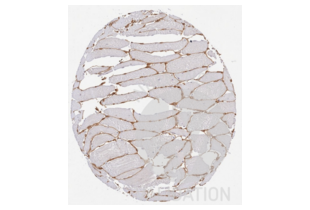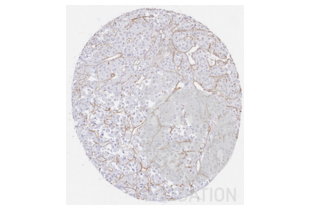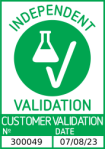Collagen IV Antikörper
-
- Target Alle Collagen IV (COL4) Antikörper anzeigen
- Collagen IV (COL4) (Collagen, Type IV (COL4))
-
Reaktivität
- Human, Rind (Kuh)
-
Wirt
- Kaninchen
-
Klonalität
- Polyklonal
-
Konjugat
- Dieser Collagen IV Antikörper ist unkonjugiert
-
Applikation
- Western Blotting (WB), ELISA, Immunohistochemistry (IHC), Immunoprecipitation (IP), Dot Blot (DB), Fluorescence Microscopy (FM)
- Hersteller Produkt- Nr.
- 600-401-106-0.1
- Hersteller
- Rockland
- Verwendungszweck
- Collagen Type IV Antibody
- Kreuzreaktivität (Details)
- Some class-specific anti-collagens may be specific for three-dimensional epitopes which may result in diminished reactivity with denatured collagen or formalin-fixed, paraffin embedded tissues.
- Produktmerkmale
- Synonyms: rabbit anti-Collagen Type IV antibody, Arresten antibody, Canstatin antibody, Collagen Of Basement Membrane Alpha 1 Chain antibody, Collagen alpha-1 (IV) chain, COL4A1
- Aufreinigung
- Anti-Collagen Type IV has been prepared by immunoaffinity chromatography using immobilized antigens followed by extensive cross-adsorption against other collagens, human serum proteins and non-collagen extracellular matrix proteins to remove any unwanted specificities.
- Sterilität
- Sterile filtered
- Immunogen
-
Immunogen: Collagen Type IV from human and bovine placenta
Immunogen Type: Native Protein
- Isotyp
- IgG
- Produktspezifische Information
-
Für welche Zwecke kann der Antikörper ABIN5596835 gegen Kollagen 4 verwendet werden? Dieser polyklonale Kollagen 4-Antikörper ist unkonjugiert und wurde für ELISA, IHC, IP und Western Blotting validiert. Als Immunogen für die Herstellung des COL4-Antikörpers wurde natives Kollagen Typ 4 aus humaner und boviner Plazenta verwendet.
Welche Validierungsdaten liegen für diesen Kollagen-4-Antikörper vor? Der Antikörper wurde bisher in 8 Pubmed-Publikationen referenziert und zeichnet sich durch hohe Zuverlässigkeit aus. Die Referenzen sind unten aufgeführt. 9 Bilder zeigen die Leistung des Produkts in verschiedenen Anwendungen.
Was ist die Funktion von Kollagen 4? Kollagen Typ 4 ist die Hauptstrukturkomponente der glomerulären Basalmembranen und bildet zusammen mit Lamininen, Proteoglykanen und Entactin/Nidogen ein "Hühnerdraht"-Geflecht. (Uniprot). Das Kollagen-4-Protein besteht aus einer aminoterminalen 7S-Domäne, einer kollagenen Domäne, die eine Dreifach-Helix bildet, und einer nicht-kollagenen Domäne am Carboxy-Terminus. Es fungiert als Teil eines Heterotrimers und interagiert mit anderen extrazellulären Matrixkomponenten wie Perlecanen, Proteoglycanen und Lamininen (NCBI)
-
-
- Applikationshinweise
-
Immunohistochemistry Dilution: 1:50 - 1:200
Application Note: Anti-Collagen Type IV has been tested by dot blot and IHC and is suitable for indirect trapping ELISA for quantitation of antigen in serum using a standard curve, immunoprecipitation, native (non-denaturing, non-dissociating) PAGE, immunohistochemistry, and western blotting for highly sensitive qualitative analysis.
Western Blot Dilution: 1:1,000 - 1:10,000
Immunoprecipitation Dilution: 1:100
ELISA Dilution: 1:5,000 - 1:50,000
IF Microscopy Dilution: User Optimized
Other: User Optimized
- Beschränkungen
- Nur für Forschungszwecke einsetzbar
-
- by
- MS Validated Antibodies
- No.
- #300049
- Datum
- 07.08.2023
- Antigen
- COL4
- Chargennummer
- 48011
- Validierte Anwendung
- Immunohistochemistry
- Positivkontrolle
Human TMA
Recombinant rabbit anti-COL4 antibody (MSVA-704R)
- Negativkontrolle
- Bewertung
Passed. Staining of collagen type IV using ABIN5596835 is consistent with the expected staining pattern.
- Primärantikörper
- ABIN5596835
- Sekundärantikörper
- EnVision Polymer-HRP mouse/rabbit Kit, Dako REAL, K5007
- Full Protocol
- Slide preparation
- Mount 2,5 µm FFPE tissue sections on superfrost slides.
- Deparaffinize tissue sections 3x 5 min in xylene.
- Rehydrate tissue sections in a descending ethanol series for 1 min each 100%, 96%, and 80% ethanol.
- Rinse tissue sections for 5 min in TBST buffer (DAKO, K8000).
- Epitope retrieval
- Autoclave tissue sections for 5 min at 121 °C in 1x Tris-EDTA-citrate buffer pH7.8 (20x Tris-EDTA-citrate buffer stock solution: 5 g Trizma base (Sigma-Aldrich, T1503), 10 g EDTA (Merck, 1.08418), 6.4g tri-sodium citrate (Sigma-Aldrich, C0909), adjust to pH 7.8 using HCL 1 M, ad 1 L with dH2O).
- Rinse tissue sections for 5 min in TBST buffer.
- Peroxidase blocking
- Incubate tissue sections for 10 min in Peroxidase-Blocking Solution (Dako REAL, S2023).
- Rinse tissue sections 2x for 5 min in TBST buffer.
- Antibody incubation
- Dilute primary rabbit anti-collagen IV antibody (antibodies-online, ABIN5596835, lot 48011) diluted 1:100, 1:200, or 1:300 in antibody diluent (Dako REAL, S2022).
- Cover tissue section with 100-200 µl diluted antibody.
- Incubate tissue sections for 1 h at 37 °C in a moist chamber.
- Rinse tissue sections for 5 min in TBST buffer.
- Apply EnVision Polymer-HRP mouse/rabbit Kit (Dako REAL, K5007) according to manufacturer’s recommendation.
- Rinse tissue sections 2x for 5 min in TBST buffer.
- Staining
- Cover slides for 10 min with DAB-Chromogen (EnVision Polymer-HRP mouse/rabbit Kit, Dako REAL, K5007).
- Wash slides thoroughly with dH2O.
- Counterstain for 15 sec with Hematoxylin (Mayers Hematoxylin: 200ml ddH2O, 0,2g Hematoxylin (Serva, 24420.02), 10 g aluminium potassium sulfate dodecahydrate (Merck, 1.01047), 0,04 g sodium iodate (Merck, 1.06525), 10 g chloral hydrate (Sigma-Aldrich, 15307)).
- Develop for 15 sec in H2O.
- Dehydrate tissue sections in an ascending ethanol series for 1 min each 80%, 96%, 100% ethanol.
- Wash tissue sectiona 3x 5 min in xylene.
- Apply mounting medium and coverslips.
- Image acquisition
- o Acquire images using a Galileo TMAtic (ISENET).
- Anmerkungen
For antibody comparison an antibody test TMA was used that contained 80 normal tissues from 21 different organs and 95 neoplastic tissues from 18 different tumor types. Despite some cytoplasmic and stromal background ABIN5596819 identified identical structures as the reference antibody MSVA-704R. An additional occasional staining of nuclei which was only seen by ABIN5596819 must be considered a cross-reactivity.
According to the rather ubiquitous nature of collagen IV expression, orthogonal validation is not optimally suited for the validation of collagen I antibodies. In agreement with RNA screening studies, including the Human Protein Atlas (HPA) RNA-seq tissue dataset, the FANTOM5 project, and the Genotype-Tissue Expression (GTEx) project (all summarized in https://www.proteinatlas.org/ENSG00000134871-COL4A2/tissue), collagen IV staining by ABIN5596819 was particularly high in the placenta, colon, smooth muscle, and the lung. These are among the tissues with the highest recorded RNA expression.
Validierung #300049 (Immunohistochemistry)![Erfolgreich validiert 'Independent Validation' Siegel]()
![Erfolgreich validiert 'Independent Validation' Siegel]() ValidierungsbilderProtokoll
ValidierungsbilderProtokoll -
- Format
- Liquid
- Konzentration
- 1.0 mg/mL
- Buffer
-
Buffer: 0.02 M Potassium Phosphate, 0.15 M Sodium Chloride, pH 7.2
Stabilizer: None
Preservative: 0.01 % (w/v) Sodium Azide - Konservierungsmittel
- Sodium azide
- Vorsichtsmaßnahmen
- This product contains Sodium azide: a POISONOUS AND HAZARDOUS SUBSTANCE which should be handled by trained staff only.
- Lagerung
- 4 °C,-20 °C
- Informationen zur Lagerung
- Store vial at 4° C prior to opening. This product is stable at 4° C as an undiluted liquid. Dilute only prior to immediate use. For extended storage, mix with an equal volume of glycerol, aliquot contents and freeze at -20° C or below. Avoid cycles of freezing and thawing.
- Haltbarkeit
- 12 months
-
-
: "Prostaglandin F2α agonist-induced suppression of 3T3-L1 cell adipogenesis affects spatial formation of extra-cellular matrix." in: Scientific reports, Vol. 10, Issue 1, pp. 7958, (2020) (PubMed).
: "Asynchronous mixing of kidney progenitor cells potentiates nephrogenesis in organoids." in: Communications biology, Vol. 3, Issue 1, pp. 231, (2020) (PubMed).
: "In Situ Imaging of Tissue Remodeling with Collagen Hybridizing Peptides." in: ACS nano, Vol. 11, Issue 10, pp. 9825-9835, (2019) (PubMed).
: "A developmentally regulated switch from stem cells to dedifferentiation for limb muscle regeneration in newts." in: Nature communications, Vol. 7, pp. 11069, (2016) (PubMed).
: "FOXD1 promotes nephron progenitor differentiation by repressing decorin in the embryonic kidney." in: Development (Cambridge, England), Vol. 141, Issue 1, pp. 17-27, (2014) (PubMed).
: "Skin shedding and tissue regeneration in African spiny mice (Acomys)." in: Nature, Vol. 489, Issue 7417, pp. 561-5, (2012) (PubMed).
: "Skin regeneration in adult axolotls: a blueprint for scar-free healing in vertebrates." in: PLoS ONE, Vol. 7, Issue 4, pp. e32875, (2012) (PubMed).
: "Genetic deletion of the angiotensin-(1-7) receptor Mas leads to glomerular hyperfiltration and microalbuminuria." in: Kidney international, Vol. 75, Issue 11, pp. 1184-1193, (2009) (PubMed).
-
: "Prostaglandin F2α agonist-induced suppression of 3T3-L1 cell adipogenesis affects spatial formation of extra-cellular matrix." in: Scientific reports, Vol. 10, Issue 1, pp. 7958, (2020) (PubMed).
-
- Target
- Collagen IV (COL4) (Collagen, Type IV (COL4))
- Andere Bezeichnung
- Collagen Type IV (COL4 Produkte)
- Hintergrund
- Background: Collagens are highly conserved throughout evolution and are characterized by an uninterrupted ''Glycine-X-Y'' triplet repeat that is a necessary part of the triple helical structure. For these reasons, it is often extremely difficult to generate antibodies with specificities to collagens. The development of 'type' specific antibodies is dependent on NON-DENATURED three-dimensional epitopes. Rockland extensively purifies collagens for immunization from human and bovine placenta and cartilage by limited pepsin digestion and selective salt precipitation. This preparation results in a native conformation of the protein. Antibodies are isolated from rabbit antiserum and are extensively cross-adsorbed by immunoaffinity purification to produce 'type' specific antibodies. Greatly diminished reactivity and selectivity of these antibodies will result if denaturing and reducing conditions are used for SDS-PAGE and immunoblotting.
- Gen-ID
- 1282
- NCBI Accession
- NP_001290039
- UniProt
- P02462
-




 (8 Referenzen)
(8 Referenzen) (1 Validierung)
(1 Validierung)




